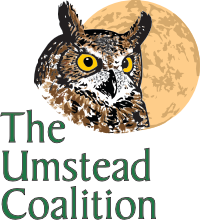The Umstead Coalition |
Forested Rain Gardens & Bioretention Areas
Forested rain gardens in the parking lot medians at the Reedy Creek Park entrance (accessed off of Harrison Avenue and I-40). The project was installed in December 2015 through the Spring of 2016. On-going modifications and maintenance in in progress.
Half of the 2 center medians were dug up, drainage installed, and a special bioretension soil mixture, covered with mulch was installed. The storm water from the parking lot has been diverted into the medians.
This project enables the treatment of all the stormwater runoff from the 1 acre impervious parking lot. In addition, trees will will grow to provide much needed shade.
We have received a $25,000 grant from Triangle Community Foundation. This project has been made possible with a grant from Triangle Community Foundation's Support for Places: Environmental Conservation Public Benefit program." We also previously received a $10,000 grant from the Wells Fargo Community Grant program. Support also was obtained by support from Great Outdoor Provision Company, Wake Stone, Raleigh Ski and Outing Club, and the NC Road Runners Club.
This project has numerous partners:
- NCSU Department of Biological and Agricultural Engineering Stormwater Group- Dr. Bill Hunt, Andrew Anderson, and Sean Kennedy designed the rain gardens, assisted with construction oversight, and installed a rain gauge and a runoff monitoring system. Runoff and rainfall data have been collected continuously on 2-minute intervals since February 5, 2015, downloaded by Umstead Coalition volunteers.
- NCSU Department of Biological and Agricultural Engineering- Dr. Karen Hall assisted with native plant selection and plantings
- Wake County Cooperative Extension Service - Mitch Woodward assisting with construction oversight and provides extensive community outreach.
- Umstead State Park staff took a key role in project approvals, construction, maintenance and community outreach.
- Grant funding from the Triangle Community Foundation's Support for Places: Environmental Conservation Public Benefit program
- Grant funding from the local Wells Fargo Community Grant program
- Grant funding from Wells Fargo Bank
- Great Outdoor Provision Company donations
- Raleigh Ski & Outing Club donations
- Donations from individuals to The Umstead Coalition
- Construction is being done by Dragonfly Pond Works
This project provides several environmental and user benefits, including: reduced runoff volume and intensity of stormwater runoff due to the infiltration into special soil media we will install in the medians. The trees and shrubs will provide much needed shade in the hot, steamy parking lot. The shade will reduce the thermal impact to the downgradiant streams.
Details: We installed innovative stormwater BMP of forested bioretention cells (rain gardens) within a 210 space parking lot median at William B. Umstead State Park. The parking area that drains to the stormwater control measure is 1.3 acres, consisting of 1 acre impervious and two center medians with an area of 0.3 acres. We installed 2 large bioretention cells in the northern halves of each of the center two medians. Each of the two cells in the median space are 18 feet wide by 180 feet long (the entire median length is 360 feet, plus the end islands). Each cell was retrofit with 3 feet of sandy loam engineered media, a 6-inch layer of washed stone, and underdrains to convey treated stormwater. The surface was topped with 2-3 inches of triple-shredded hardwood mulch and planted with trees, shrubs, and herbaceous perennials.
Two innovative features: 1) trees to provide shade, whose survival will be improved by an 2) internal water storage zone created by 90-degree elbows in the underdrain, which will improve nitrogen treatment and increase total annual volume reduction.
A key focus is the planting of native trees, complemented by an understory of other native vegetation that can survive in a combination of wet and droughty periods. Tree species planted (tentative list, will be updated with actual): bald cypress (Taxodium distichum) (slower growing, with stunning fall colors). Understory trees and bushes include: dogwood (Cornus florida) and beauty berry (Callicarpa americana). Native grasses will include switch grass (Panicum virgatum) and river oats (Chasmanthium latifolium). As overstory tree canopy closes, shade will limit native grass growth but not understory tree and shrub growth.
We also installed 2 monarch butterfly gardens in raised beds. They are located along the walkway to the bath house.
